Sudoku


Sudoku (数独 sūdoku, digit-single) (![]() i/suːˈdoʊkuː/, /-ˈdɒ-/, /sə-/, originally called Number Place),[1] is a logic-based,[2][3] combinatorial[4] number-placement puzzle. The objective is to fill a 9×9 grid with digits so that each column, each row, and each of the nine 3×3 subgrids that compose the grid (also called "boxes", "blocks", "regions", or "subsquares") contains all of the digits from 1 to 9. The puzzle setter provides a partially completed grid, which for a well-posed puzzle has a unique solution.
i/suːˈdoʊkuː/, /-ˈdɒ-/, /sə-/, originally called Number Place),[1] is a logic-based,[2][3] combinatorial[4] number-placement puzzle. The objective is to fill a 9×9 grid with digits so that each column, each row, and each of the nine 3×3 subgrids that compose the grid (also called "boxes", "blocks", "regions", or "subsquares") contains all of the digits from 1 to 9. The puzzle setter provides a partially completed grid, which for a well-posed puzzle has a unique solution.
Completed games are always a type of Latin square with an additional constraint on the contents of individual regions. For example, the same single integer may not appear twice in the same row, column, or any of the nine 3×3 subregions of the 9x9 playing board.
French newspapers featured variations of the puzzles in the 19th century, and the puzzle has appeared since 1979 in puzzle books under the name Number Place.[5] However, the modern Sudoku only started to become mainstream in 1986 by the Japanese puzzle company Nikoli, under the name Sudoku, meaning "single number".[6] It first appeared in a US newspaper and then The Times (UK) in 2004, from the efforts of Wayne Gould, who devised a computer program to rapidly produce distinct puzzles.
History
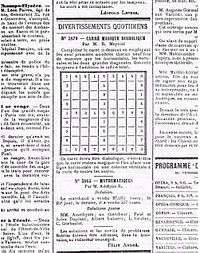
Number puzzles appeared in newspapers in the late 19th century, when French puzzle setters began experimenting with removing numbers from magic squares. Le Siècle, a Paris daily, published a partially completed 9×9 magic square with 3×3 subsquares on November 19, 1892.[7] It was not a Sudoku because it contained double-digit numbers and required arithmetic rather than logic to solve, but it shared key characteristics: each row, column and subsquare added up to the same number.
On July 6, 1895, Le Siècle's rival, La France, refined the puzzle so that it was almost a modern Sudoku. It simplified the 9×9 magic square puzzle so that each row, column, and broken diagonals contained only the numbers 1–9, but did not mark the subsquares. Although they are unmarked, each 3×3 subsquare does indeed comprise the numbers 1–9 and the additional constraint on the broken diagonals leads to only one solution.[8]
These weekly puzzles were a feature of French newspapers such as L'Echo de Paris for about a decade, but disappeared about the time of World War I.[9]
The modern Sudoku was most likely designed anonymously by Howard Garns, a 74-year-old retired architect and freelance puzzle constructor from Connersville, Indiana, and first published in 1979 by Dell Magazines as Number Place (the earliest known examples of modern Sudoku).[1] Garns's name was always present on the list of contributors in issues of Dell Pencil Puzzles and Word Games that included Number Place, and was always absent from issues that did not.[10] He died in 1989 before getting a chance to see his creation as a worldwide phenomenon.[10] Whether or not Garns was familiar with any of the French newspapers listed above is unclear.
The puzzle was introduced in Japan by Nikoli in the paper Monthly Nikolist in April 1984[10] as Sūji wa dokushin ni kagiru (数字は独身に限る), which also can be translated as "the digits must be single" or "the digits are limited to one occurrence" (In Japanese, dokushin means an "unmarried person"). At a later date, the name was abbreviated to Sudoku (数独) by Maki Kaji (鍜治 真起 Kaji Maki), taking only the first kanji of compound words to form a shorter version.[10] "Sudoku" is a registered trademark in Japan and the puzzle is generally referred to as Number Place (ナンバープレース Nanbāpurēsu) or, more informally, a portmanteau of the two words, Num(ber) Pla(ce) (ナンプレ Nanpure). In 1986, Nikoli introduced two innovations: the number of givens was restricted to no more than 32, and puzzles became "symmetrical" (meaning the givens were distributed in rotationally symmetric cells). It is now published in mainstream Japanese periodicals, such as the Asahi Shimbun.
The Times of London began featuring Sudoku in late 2004 after a successful appearance in a local US newspaper, from the efforts of Wayne Gould, and rapidly spread to other newspapers as a regular feature.[5][11] Gould devised a computer program to produce unique puzzles rapidly.[5]
Variants


Variations of grid sizes
Although the 9×9 grid with 3×3 regions is by far the most common, many other variations exist. Sample puzzles can be 4×4 grids with 2×2 regions; 5×5 grids with pentomino regions have been published under the name Logi-5; the World Puzzle Championship has featured a 6×6 grid with 2×3 regions and a 7×7 grid with six heptomino regions and a disjoint region. Larger grids are also possible. The Times offers a 12×12-grid "Dodeka Sudoku" with 12 regions of 4×3 squares. Dell Magazines regularly publishes 16×16 "Number Place Challenger" puzzles (using the numbers 1-16 or the letters A-P). Nikoli offers 25×25 "Sudoku the Giant" behemoths. A 100×100-grid puzzle dubbed Sudoku-zilla was published in 2010.[12]
Imposing additional constraints
Another common variant is to add limits on the placement of numbers beyond the usual row, column, and box requirements. Often, the limit takes the form of an extra "dimension"; the most common is to require the numbers in the main diagonals of the grid to also be unique. The aforementioned "Number Place Challenger" puzzles are all of this variant, as are the Sudoku X puzzles in The Daily Mail, which use 6×6 grids.
Mini Sudoku
A variant named "Mini Sudoku" appears in the American newspaper USA Today and elsewhere, which is played on a 6×6 grid with 3×2 regions. The object is the same as that of standard Sudoku, but the puzzle only uses the numbers 1 through 6. A similar form, for younger solvers of puzzles, called "The Junior Sudoku", has appeared in some newspapers, such as some editions of The Daily Mail.
Killer Sudoku

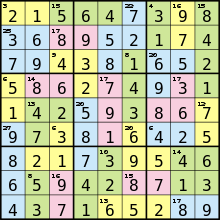
The Killer Sudoku variant combines elements of Sudoku and Kakuro.
Alphabetical Sudoku

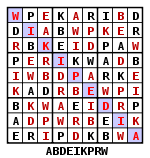
Alphabetical variations have emerged, sometimes called Wordoku; no functional difference exists in the puzzle unless the letters spell something. Some variants, such as in the TV Guide, include a word reading along a main diagonal, row, or column once solved; determining the word in advance can be viewed as a solving aid. A Wordoku might contain words other than the main word.
"Quadratum latinum" is a Sudoku variation with Roman numerals (I, II, III, IV, ..., IX) proposed by Hebdomada aenigmatum, a monthly magazine of Latin puzzles and crosswords. Like the Wordoku, it presents no functional difference from a normal Sudoku, but adds the visual difficulty of using Roman numerals.
Hypersudoku
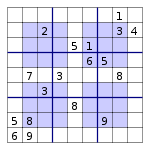
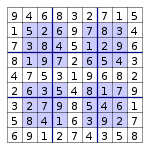
Hypersudoku is one of the most popular variants. It is published by newspapers and magazines around the world and is also known as "NRC Sudoku", "Windoku", "Hyper-Sudoku", and "4 Square Sudoku". The layout is identical to a normal Sudoku, but with additional interior squares defined in which the numbers 1 to 9 must appear. The solving algorithm is slightly different from the normal Sudoku puzzles because of the emphasis on the overlapping squares. This overlap gives the player more information to logically reduce the possibilities in the remaining squares. The approach to playing is similar to Sudoku, but with possibly more emphasis on scanning the squares and overlap rather than columns and rows.
Other variants
Puzzles constructed from multiple Sudoku grids are common. Five 9×9 grids that overlap at the corner regions in the shape of a quincunx is known in Japan as Gattai 5 (five merged) Sudoku. In The Times, The Age, and The Sydney Morning Herald, this form of puzzle is known as Samurai SuDoku. The Baltimore Sun and the Toronto Star publish a puzzle of this variant (titled High Five) in their Sunday edition. Often, no givens are placed in the overlapping regions. Sequential grids, as opposed to overlapping, are also published, with values in specific locations in grids needing to be transferred to others.
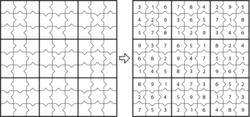
A tabletop version of Sudoku can be played with a standard 81-card Set deck (see Set game). A three-dimensional Sudoku puzzle was published in The Daily Telegraph in May 2005. The Times also publishes a three-dimensional version under the name Tredoku. Also, a Sudoku version of the Rubik's Cube is named Sudoku Cube.
Many other variants have been developed.[13][14][15] Some are different shapes in the arrangement of overlapping 9×9 grids, such as butterfly, windmill, or flower.[16] Others vary the logic for solving the grid. One of these is "Greater Than Sudoku". In this, a 3×3 grid of the Sudoku is given with 12 symbols of Greater Than (>) or Less Than (<) on the common line of the two adjacent numbers.[10] Another variant on the logic of solution is "Clueless Sudoku", in which nine 9×9 Sudoku grids are each placed in a 3×3 array. The center cell in each 3×3 grid of all nine puzzles is left blank and form a tenth Sudoku puzzle without any cell completed; hence, "clueless".[16]
Mathematics of Sudoku
The results in the following text refer to classic Sudoku, disregarding jigsaw, hyper, and others.
A completed Sudoku grid is a special type of Latin square with the additional property of no repeated values in any of the nine blocks of contiguous 3×3 cells. The relationship between the two theories is now completely known, after it was proven that a first-order formula that does not mention blocks (also called boxes or regions) is valid for Sudoku if and only if it is valid for Latin squares (this property is trivially true for the axioms and it can be extended to any formula).[17]
The number of classic 9×9 Sudoku solution grids is 6,670,903,752,021,072,936,960 (sequence A107739 in the OEIS), or around 6.67×1021. This is roughly 1.2×10−6 times the number of 9×9 Latin squares.[18] Various other grid sizes have also been enumerated—see the main article for details. The number of essentially different solutions, when symmetries such as rotation, reflection, permutation, and relabelling are taken into account, was shown to be just 5,472,730,538[19] (sequence A109741 in the OEIS).
Unlike the number of complete Sudoku grids, the number of minimal 9×9 Sudoku puzzles is not precisely known. (A minimal puzzle is one in which no clue can be deleted without losing uniqueness of the solution.) However, statistical techniques combined with the definition of a new type of generator[20] allow showing that about (with 0.065% relative error) 3.10 × 1037 minimal puzzles and 2.55 × 1025 nonessentially equivalent minimal puzzles exist.
The maximum number of givens provided while still not rendering a unique solution is four short of a full grid (77); if two instances of two numbers each are missing from cells that occupy the corners of an orthogonal rectangle, and exactly two of these cells are within one region, the numbers can be assigned two ways. Since this applies to Latin squares in general, most variants of Sudoku have the same maximum. The inverse problem—the fewest givens that render a solution unique—was proven to be 17 in January 2012 (confirmed in September 2013).[21][22] A number of valid puzzles with 17 givens has been found for the standard variation without a symmetry constraint, by Japanese puzzle enthusiasts,[23][24] and 18 with the givens in rotationally symmetric cells. Over 49,000 examples of Sudoku puzzles with 17 givens resulting in a unique solution are known.[25]
The arrangement of numbers in Sudoku puzzles have greater Shannon entropy than the number arrangements in randomly generated 9×9 matrices because the rules of Sudoku exclude some random arrangements that have an innate symmetry.[26]
The general problem of solving Sudoku puzzles on n2 × n2 boards of n × n blocks is known to be NP-complete.[27]
A popular approach to quickly solve any Sudoku puzzle is programming an application of dancing links, with typical results in milliseconds for a 9×9 Sudoku. Although it does not indicate how hard the puzzle would be for humans, at least it is known if the solution is unique, not possible, or how many possible solutions exist.
Popularity since 1997 outside Japan
In 1997, Wayne Gould saw a partly completed puzzle in a Japanese bookshop. Over six years, he developed a computer program to produce puzzles quickly. Knowing that British newspapers have a long history of publishing crosswords and other puzzles, he promoted Sudoku to The Times in Britain, which launched it on November 12, 2004 (calling it Su Doku). The first letter to The Times regarding Su Doku was published the following day on November 13 from Ian Payn of Brentford, complaining that the puzzle had caused him to miss his stop on the tube.[28]
The rapid rise of Sudoku in Britain from relative obscurity to a front-page feature in national newspapers attracted commentary in the media and parody (such as when The Guardian's G2 section advertised itself as the first newspaper supplement with a Sudoku grid on every page).[29] Recognizing the different psychological appeals of easy and difficult puzzles, The Times introduced both, side by side, on June 20, 2005. From July 2005, Channel 4 included a daily Sudoku game in their Teletext service. On August 2, the BBC's program guide Radio Times featured a weekly Super Sudoku with a 16×16 grid.
In the United States, the first newspaper to publish a Sudoku puzzle by Wayne Gould was The Conway Daily Sun (New Hampshire), in 2004.[30]

The world's first live TV Sudoku show, Sudoku Live, was a puzzle contest first broadcast on July 1, 2005, on Sky One. It was presented by Carol Vorderman. Nine teams of nine players (with one celebrity in each team) representing geographical regions competed to solve a puzzle. Each player had a hand-held device for entering numbers corresponding to answers for four cells. Phil Kollin of Winchelsea, England, was the series grand prize winner, taking home over £23,000 over a series of games. The audience at home was in a separate interactive competition, which was won by Hannah Withey of Cheshire.
Later in 2005, the BBC launched SUDO-Q, a game show that combines Sudoku with general knowledge. However, it uses only 4×4 and 6×6 puzzles. Four seasons were produced, before the show ended in 2007.
In 2006, a Sudoku website published songwriter Peter Levy's Sudoku tribute song,[31] but quickly had to take down the MP3 file due to heavy traffic. British and Australian radio picked up the song, which is to feature in a British-made Sudoku documentary. The Japanese Embassy also nominated the song for an award, with Levy doing talks with Sony in Japan to release the song as a single.[32]
Sudoku software is very popular on PCs, websites, and mobile phones. It comes with many distributions of Linux. Software has also been released on video game consoles, such as the Nintendo DS, PlayStation Portable, the Game Boy Advance, Xbox Live Arcade, the Nook e-book reader, Kindle Fire tablet, several iPod models, and the iPhone. Also many Nokia phones had Sudoku, too. In fact, just two weeks after Apple Inc. debuted the online App Store within its iTunes Store on July 11, 2008, nearly 30 different Sudoku games were already in it, created by various software developers, specifically for the iPhone and iPod Touch. One of the most popular video games featuring Sudoku is Brain Age: Train Your Brain in Minutes a Day!. Critically and commercially well-received, it generated particular praise for its Sudoku implementation[33][34][35] and sold more than 8 million copies worldwide.[36] Due to its popularity, Nintendo made a second Brain Age game titled Brain Age2, which has over 100 new Sudoku puzzles and other activities.
In June 2008, an Australian drugs-related jury trial costing over A$1 million was aborted when it was discovered that five of the 12 jurors had been playing Sudoku instead of listening to evidence.[37]
Competitions
- The first World Sudoku Championship was held in Lucca, Italy, from March 10 to 12, 2006. The winner was Jana Tylová of the Czech Republic.[38] The competition included numerous variants.[39]
- The second World Sudoku Championship was held in Prague from March 28 to April 1, 2007.[40] The individual champion was Thomas Snyder of the USA. The team champion was Japan.[41]
- The third World Sudoku Championship was held in Goa, India, from April 14 to 16, 2008. Thomas Snyder repeated as the individual overall champion, and also won the first ever Classic Trophy (a subset of the competition counting only classic Sudoku). The Czech Republic won the team competition.[42]
- The fourth World Sudoku Championship was held in Žilina, Slovakia, from April 24 to 27, 2009. After past champion Thomas Snyder of the USA won the general qualification, Jan Mrozowski of Poland emerged from a 36-competitor playoff to become the new World Sudoku Champion. Host nation Slovakia emerged as the top team in a separate competition of three-membered squads.[43]
- The fifth World Sudoku Championship was held in Philadelphia from April 29 to May 2, 2010. Jan Mrozowski of Poland successfully defended his world title in the individual competition, while Germany won a separate team event. The puzzles were written by Thomas Snyder and Wei-Hwa Huang, both past US Sudoku champions.[44]
- In the United States, The Philadelphia Inquirer Sudoku National Championship has been held three times, each time offering a $10,000 prize to the advanced division winner and a spot on the U.S. National Sudoku Team traveling to the world championships. The winners of the event were Thomas Snyder (2007),[45] Wei-Hwa Huang (2008), and Tammy McLeod (2009).[46] In the most recent event, the third-place finalist in the advanced division, Eugene Varshavsky, performed quite poorly onstage after setting a very fast qualifying time on paper, which caught the attention of organizers and competitors including past champion Thomas Snyder, who requested organizers reconsider his results due to a suspicion of cheating.[47] Following an investigation and a retest of Varshavsky, the organizers disqualified him and awarded Chris Narrikkattu third place.[48]
See also
References
- 1 2 Grossman, Lev (March 11, 2013). "The Answer Men". Time. Retrieved March 4, 2013.(registration required)
- ↑ Arnoldy, Ben. "Sudoku Strategies". The Home Forum. The Christian Science Monitor.
- ↑ Schaschek, Sarah (March 22, 2006). "Sudoku champ's surprise victory". The Prague Post. Archived from the original on August 13, 2006. Retrieved February 18, 2009.
- ↑ Lawler, E. L. (1985). The Traveling Salesman Problem: A Guided Tour of Combinatorial Optimization. West Sussex: John Wiley & Sons. ISBN 0-471-90413-9.
- 1 2 3 Smith, David (May 15, 2005). "So you thought Sudoku came from the Land of the Rising Sun ...". The Observer. Retrieved June 13, 2008.
The puzzle gripping the nation actually began at a small New York magazine
- ↑ Hayes, Brian (2006). "Unwed Numbers". American Scientist. 94 (1): 12–15. doi:10.1511/2006.57.3475.
- ↑ Boyer, Christian (May 2006). "Supplément de l'article " Les ancêtres français du sudoku "" (PDF). Pour la Science (reprint): 1–6. Archived from the original (PDF) on December 10, 2006. Retrieved August 3, 2009.
- ↑ Boyer, Christian (2007). "Sudoku's French ancestors". (personal webpage). Archived from the original on October 10, 2007. Retrieved August 3, 2009.
- ↑ Malvern, Jack (June 3, 2006). "Les fiendish French beat us to Su Doku". Times Online. London. Retrieved September 16, 2006.
- 1 2 3 4 5 Pegg, Ed, Jr. (September 15, 2005). "Ed Pegg Jr.'s Math Games: Sudoku Variations". MAA Online. The Mathematical Association of America. Retrieved October 3, 2006.
- ↑ Devlin, Keith (January 28–29, 2012). "The Numbers Game (book review of Taking Sudoku Seriously by Jason Rosenhouse et al.)". The Wall Street Journal. Weekend Edition. p. C5.
- ↑ Eisenhauer, William (2010). Sudoku-zilla. CreateSpace. p. 220. ISBN 978-1-4515-1049-2.
- ↑
- Snyder, Thomas; Huang, Wei-Hwa (2009). Mutant Sudoku. Puzzlewright Press. ISBN 978-1-402765025.
- ↑ Conceptis, Puzzles (2013). Amazing Sudoku Variants. Puzzlewright. ISBN 978-1454906520.
- ↑ Murali, A V (2014). A Collection of Fascinating Games and Puzzles. CreateSpace Independent Publishing Platform. ISBN 978-1500216429.
- 1 2 "Zahlenraetsel". www.janko.at.
- ↑ Berthier, Denis (2007). The Hidden Logic of Sudoku. LULU PR. p. 76 N. ISBN 1-84753-472-4.
p. 76.: "any block-free resolution rule is already valid in the theory of Latin Squares extended to candidates". Restated more explicitly in the second edition, p. 86, as: "a block-free formula is valid for Sudoku if and only if it is valid for Latin squares"
- ↑ Jarvis, Frazer (July 31, 2006). "Sudoku enumeration problems". Frazer Jarvis's home page. Retrieved September 16, 2006. Detailed calculation of this figure.
- ↑ Jarvis, Frazer; Russell, Ed (September 7, 2005). "There are 5472730538 essentially different Sudoku grids ... and the Sudoku symmetry group". Frazer Jarvis's home page. Retrieved September 16, 2006.
- ↑ Berthier, Denis (December 4, 2009). "Unbiased Statistics of a CSP – A Controlled-Bias Generator". In Elleithy, Khaled. Innovations in Computing Sciences and Software Engineering. pp. 165–70. Retrieved December 4, 2009.
- ↑ G. McGuire, B. Tugemann, G. Civario. "There is no 16-Clue Sudoku: Solving the Sudoku Minimum Number of Clues Problem". Arxiv.org.
- ↑ H.H. Lin, I-C. Wu. "No 16-clue Sudoku puzzles by sudoku@vtaiwan project", September, 2013.
- ↑ プログラミングパズルに関心のある人は雑談しましょう. プログラミングパズル雑談コーナー / Programming Puzzle Idle Talk Corner (in Japanese). Retrieved September 16, 2006.
- ↑ Royle, Gordon. "Minimum Sudoku". Retrieved September 16, 2006.
- ↑ Royle, Gordon. "Minimum Sudoku". Retrieved February 28, 2012.
- ↑ Newton, Paul K.; DeSalvo, Stephen A. (2009). "The Shannon entropy of Sudoku matrices". Proceedings of the Royal Society A. doi:10.1098/rspa.2009.0522.
- ↑ "NP complete – Sudoku" (PDF) (in Japanese). Imai.is.su-tokyo.ac.jp. Retrieved 2013-10-20.
- ↑ "Letters". Timesonline.co.uk. November 14, 2004. (subscription required)
- ↑ "G2, home of the discerning Sudoku addict". The Guardian. London. May 13, 2005. Retrieved September 16, 2006.
- ↑ Correction attached to "Inside Japan's Puzzle Palace". New York Times. March 21, 2007.
- ↑ "Sudoku the song, by Peter Levy". Sudoku.org.uk. August 17, 2006. Retrieved October 5, 2008.
- ↑ "Hit Song Has the Numbers". The Herald Sun. August 17, 2006. Retrieved October 5, 2008.
- ↑ "Brain Age: Train Your Brain in Minutes a Day!". Gamerankings.com.
- ↑ "Brain Age: ... Review". Gamespot.com.
- ↑ "Brain Age: ... Review". IGN.com.
- ↑ Thorsen, Tor (October 26, 2006). "Nintendo posts $456.6 million profit". GameSpot. Retrieved March 29, 2013.
- ↑ Knox, Malcolm (June 11, 2008). "The game's up: jurors playing Sudoku abort trial". The Sydney Morning Herald. Retrieved June 11, 2008.
- ↑ "Sudoku title for Czech accountant". BBC News. March 11, 2006. Retrieved September 11, 2006.
- ↑ "World Sudoku Championship 2006 Instructions Booklet" (PDF). BBC News. Retrieved May 24, 2010.
- ↑ "Report on the 8th General Assembly of the World Puzzle Federation". World Puzzle Federation. October 30, 2006. Retrieved November 15, 2006.
- ↑ "Thomas Snyder wins World Sudoku Championship". US Puzzle Team. March 31, 2007. Retrieved April 18, 2008.
- ↑ Harvey, Michael (April 17, 2008). "It's a puzzle but sun, sea and beer can't compete with Sudoku for British team". TimesOnline. London. Retrieved April 18, 2008.
- ↑ Malvern, Jack (April 27, 2009). "Su Doku battle goes a little off the wall". TimesOnline. London. Retrieved April 27, 2009.
- ↑ "Pole, 23, repeats as Sudoku world champ". PhillyInquirer. May 2, 2009. Archived from the original on 2010-05-05. Retrieved August 3, 2013.
- ↑ "Thomas Snyder, World Sudoku champion". Philadelphia Inquirer. October 21, 2007. Retrieved October 21, 2007.
- ↑ Shapiro, Howard (October 25, 2009). "Going for 2d, she wins 1st". Philadelphia Inquirer. Archived from the original on 2009-11-02. Retrieved August 3, 2013.
- ↑ Timpane, John (October 27, 2009). "Possible cheating probed at Sudoku National Championship". Philadelphia Inquirer. Archived from the original on 2009-11-01. Retrieved August 3, 2013.
- ↑ "3rd-place winner disqualified in sudoku scandal". Philadelphia Inquirer. November 24, 2009. Archived from the original on 2009-11-27. Retrieved August 3, 2013.
Further reading
- Delahaye, Jean-Paul, "The Science Behind Sudoku", Scientific American magazine, June 2006.
- Provan, J. Scott, "Sudoku: Strategy Versus Structure", American Mathematical Monthly, October 2009. Published also as a University of North Carolina technical report UNC/STOR/08/04, 2008.
External links
| Wikimedia Commons has media related to Sudoku. |
- Sudoku at DMOZ – An active listing of Sudoku links
- 'Father of Sudoku' puzzles next move (BBC)